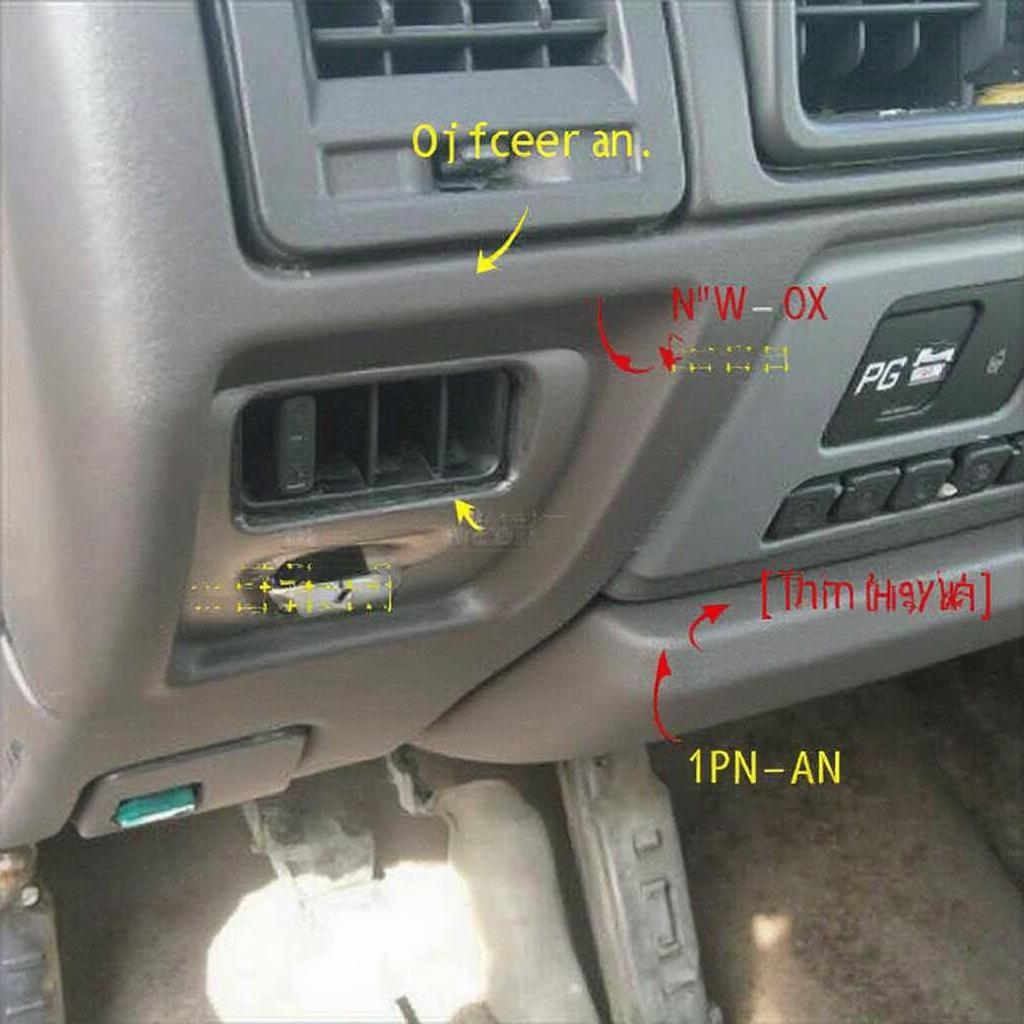Determining whether your 1996 Ford F250 uses OBD1 or OBD2 is crucial for proper diagnostics and maintenance. This guide provides a clear answer and explores the key differences between these two diagnostic systems. We’ll cover everything you need to know about diagnosing your 1996 F250, from understanding the regulations to choosing the right OBD2 scanner.
Most 1996 Ford F250 trucks came equipped with the OBD2 system. However, some early production models might still have the OBD1 system. The easiest way to confirm is to check the Vehicle Emission Control Information (VECI) label usually located under the hood or on the driver’s side doorjamb. If it states “OBD II Certified,” your truck uses OBD2. If you can’t find the label, check the diagnostic connector located under the dashboard on the driver’s side. An OBD2 connector is trapezoidal with 16 pins, while an OBD1 connector varies depending on the manufacturer.
For those with a 1996 F250 running OBD2, you’ll find a wealth of diagnostic tools and information available. OBD2 scanners allow you to read and clear trouble codes, monitor live data, and perform various tests. This access to information empowers you to troubleshoot issues and understand your vehicle’s performance better.
 1996 F250 OBD2 Connector Location and Identification
1996 F250 OBD2 Connector Location and Identification
Understanding OBD1 and OBD2 in Your 1996 F250
OBD1, or On-Board Diagnostics generation one, is a simpler system than OBD2. It typically uses manufacturer-specific connectors and protocols, making it less standardized than OBD2. OBD2, introduced in 1996, standardized diagnostics across all vehicle makes and models sold in the United States. This standardization simplified troubleshooting and improved emissions monitoring.
The shift to OBD2 was a significant step towards cleaner air. The more sophisticated system allowed for more precise monitoring of emissions-related components, leading to better control and reduced pollution. The standardized connector and protocols made it easier for mechanics and vehicle owners to diagnose and repair emissions problems.
Locating the Diagnostic Port on a 1996 F250
The diagnostic port on a 1996 F250 is typically located under the dashboard on the driver’s side. You may need to look up under the steering column or around the fuse box area. The port is usually a trapezoidal shape with 16 pins for OBD2 vehicles. However, if your F250 is an early 1996 model with OBD1, the connector may vary. Consulting the vehicle’s service manual can provide specific location details. For more insights into using OBD2 apps with Ford Triton engines, you can check out our guide on ford triton obd2 app.
Using an OBD2 Scanner on your 1996 F250
Once you’ve located the port, using an OBD2 scanner is straightforward. Simply plug the scanner into the port and turn the ignition key to the “on” position (without starting the engine). The scanner will then power up and allow you to access various diagnostic functions, including reading and clearing trouble codes, viewing live data, and performing system tests.
“A good quality OBD2 scanner is an essential tool for any 1996 F250 owner,” says John Davis, a seasoned automotive technician. “It can save you time and money by helping you diagnose problems quickly and efficiently.”
Why Knowing Your OBD System Matters
Identifying the correct OBD system is crucial for choosing compatible diagnostic tools and interpreting the information they provide. Using the wrong scanner or misinterpreting codes can lead to incorrect diagnoses and unnecessary repairs. More information about this specific year model can be found in our dedicated article: 96 f250 obd1 or obd2.
“Knowing your F250’s OBD system is the first step towards effective troubleshooting,” adds Sarah Miller, an automotive engineer. “It allows you to select the right tools and resources for accurate diagnosis.”
Conclusion
Knowing whether your 1996 F250 uses OBD1 or OBD2 is essential for proper diagnostics. By understanding the differences between these systems, you can choose the right tools and accurately interpret the information they provide, ultimately saving you time and money. Using the right OBD2 scanner on your 1996 F250 will empower you to maintain your truck efficiently and effectively.
FAQ
-
What is OBD? OBD stands for On-Board Diagnostics, a system that monitors your vehicle’s emissions and performance.
-
Why is OBD2 important? OBD2 standardizes diagnostics, making it easier to troubleshoot issues and improve emissions monitoring.
-
How do I know if my 1996 F250 has OBD2? Check the VECI label or the diagnostic connector.
-
Where is the OBD2 port located? Typically under the dashboard on the driver’s side.
-
What does an OBD2 scanner do? It reads and clears trouble codes, monitors live data, and performs tests.
-
Why do I need to know my F250’s OBD system? To choose the right diagnostic tools and interpret information correctly.
-
What if my 1996 F250 has OBD1? You’ll need a manufacturer-specific scanner.
Need help? Contact us via WhatsApp: +1(641)206-8880, Email: [email protected] or visit us at 789 Elm Street, San Francisco, CA 94102, USA. We offer 24/7 customer support.

